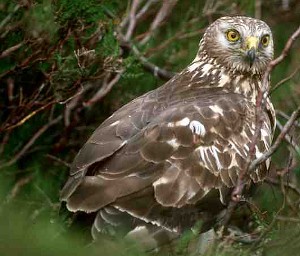
Hen Harrier (Photo:SNH)
Over the last three years, Scottish Natural Heritage (SNH) has been working with land managers in the Clyde Muirshiel Regional Park to support management of their moorland for wildlife. In all ten land managers have signed up to a management scheme, covering 8,380 hectares of moorland.
Known as Renfrewshire Heights, the moorland is internationally important for breeding hen harriers and it is designated as a Site of Special Scientific Interest (SSSI) and Special Protection Area.
Over a number of years muirburn and high levels of grazing have caused a loss of heather cover on the moor, affecting not only the habitat but also the wildlife which lives there, including the hen harrier.
The scheme, which runs until 2014, will restore moorland habitat by reducing grazing and carefully targeting muirburn. It will benefit not only harriers, but also other moorland wildlife, with measures to regenerate scrub and mark fences to stop black grouse flying into them.
Hunterston Estate is one of the landholdings that has signed up to the scheme. With a five-year agreement that covers 1,368 ha of land, the estate plans to reduce the number of grazing sheep by 900. At their own expense, they have also removed a further 1,000 sheep and put a new, summer-only grazing regime in place for 390 sheep and 30 cattle. The estate has also stopped muirburn throughout the term of the agreement. The changes will maintain a good diversity of habitats and help the heather to recover.
Nigel Cochran-Patrick, of Hunterston Estate, said: “We have fully embraced the SSSI at Renfrewshire Heights and have embarked on an environmental scheme that will encourage the regeneration and increased biodiversity of the land holding. This is a great opportunity to reverse the desertification caused by years of overgrazing and the inopportune drainage schemes of the past.
“My only worry is that the five years that the scheme runs for will only just be enough time to halt the decline; hopefully the scheme will run for a further five years to really make a difference. People forget how long things in nature take to grow.”
Andy MacGregor from Scottish Natural Heritage said: “These moorlands are one of the best breeding sites for hen harriers in Scotland. The scheme has helped farmers and estates continue their good stewardship of the land by improving the habitat – we hope this will help the wildlife here thrive for years to come.”
Financial help for land managers to improve the condition of protected nature sites is available through the Scotland Rural Development Programme (SRDP). There are more than 1,400 places in Scotland recognised for their nature conservation importance. Within these are around 5,400 protected species, habitats and geological features. In 2005, 71% of these features were reported to be in favourable condition. Thanks to the efforts of private land managers, wildlife charities and public bodies, this has since increased to 78%, though this is still short of the Scottish Government target of 95%.
